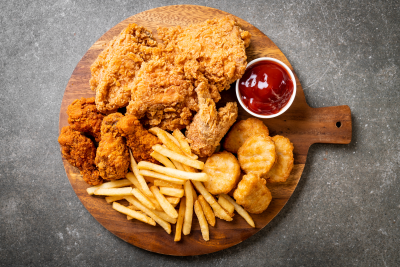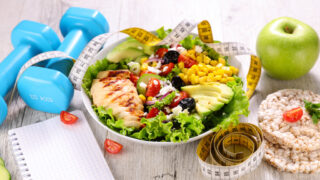What to eat and avoid after a stroke

Is Diet Important?
After having a stroke, diet is an important part of recovering and preventing another one. Eating healthy foods can help manage risk factors for stroke such as high blood pressure, high cholesterol, obesity, and diabetes. Along with knowing the proper foods to eat and avoid, it can be helpful to learn how to read food labels, meal prep, and consult with a dietician.
Foods to Avoid
Processed foods – processed foods have lots of fats, starches, sugars and hydrogenated oils, and raise your cholesterol, your blood pressure and your stroke risk.
This includes foods like:
- Processed meats like hot dogs, salami, pepperoni and bologna.
- Refined carbs like white breads, crackers, salty snack foods and baked goods.
- Sugary foods and drinks, such as desserts, candy and soda.
- Fried foods, such as mozzarella sticks, chicken fingers, popcorn shrimp, etc.
- Fast foods and convenience foods, like canned soup, frozen dinners.

Food high in salt
Eating too much sodium can cause you to retain fluids, which increases your blood pressure and is a risk factor for stroke. A low-sodium diet is one with less than 2,400 milligrams of sodium a day, but the average American consumes about twice as much sodium as they should. Processed foods are also high in sodium, which is used as a preservative. There are also lots of hidden forms of salt in things like salad dressings, soy sauce, and seasonings. An alternative can be to try other herbs and salt free spices to your food.
Foods to Eat
Whole foods
Whole foods are foods that are found in nature and not processed. Try to incorporate these foods into your snacks and meals.
This includes:
- Fruit
- Vegetables
- Poultry
- Lean protein
- Fish
- Whole grains (like oats, barley, brown or wild rice)
- Legumes (like beans and peas)
- Nuts and seeds
High fiber foods
Fiber can help reduce your cholesterol and your overall risk for cardiovascular disease. Soluble fiber binds to the bile in your gut, which helps eliminate it. Bile is made of cholesterol, so a diet high in soluble fiber can lower cholesterol. Soluble fiber is found in foods like oats, legumes, root vegetables, apples, pears, citrus fruits, chia, flaxseeds and psyllium husk.
Summary:
- Steer clear of processed meats, refined carbs, sugary foods/drinks, and fried/fast foods.
- Be mindful of high-sodium foods as they can raise blood pressure; opt for a low-sodium diet.
- Watch for hidden salt in salad dressings, soy sauce, and seasonings; explore salt-free alternatives.
- Prioritize natural, unprocessed whole foods like fruits, vegetables, poultry, lean protein, fish, and whole grains.
- Include high-fiber foods, especially soluble fiber sources like oats, legumes, fruits, and seeds.
- Opt for a diet rich in soluble fiber to bind bile in the gut, reducing cholesterol levels.
- Consider consulting with a dietitian for personalized advice on reading labels and meal preparation.

This article reviewed by Dr. Jim Liu, MD and Ms. Deb Dooley, APRN.
There’s nothing more important than our good health – that’s our principal capital asset.
#medical #telehealth #umedoc






